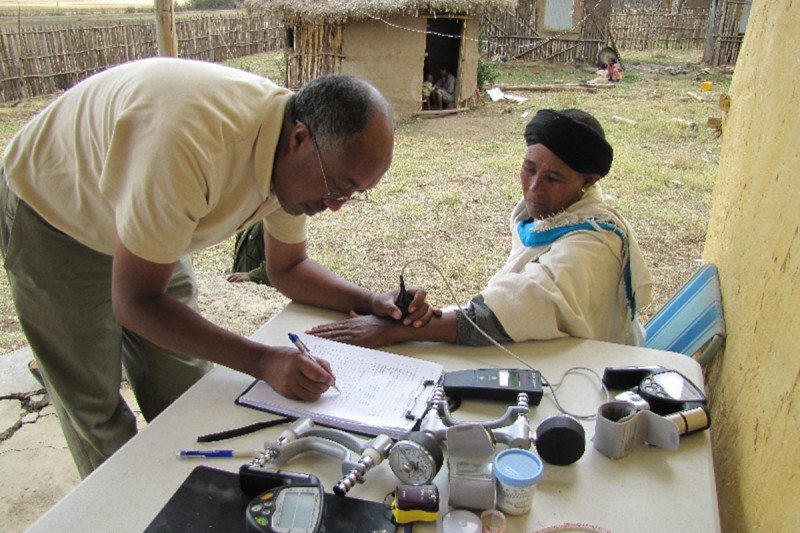
© Courtesy of the Tishkoff labResearcher in the field measures skin colour
Skin tone has varied greatly among humans for at least the last 900,000 years. So concludes an analysis of the genetic variants associated with skin pigmentation in people from several regions of Africa.
The latest findings suggest that some particularly dark skin tones evolved relatively recently from paler genetic variants, underlining how deeply flawed the racist concept of people with whiter skin being "more advanced" really is.Nicholas Crawford and Sarah Tishkoff at the University of Pennsylvania in Philadelphia recruited around 1500 ethnically and genetically diverse volunteers living in Ethiopia, Tanzania and Botswana for their study. Each person agreed to provide a DNA sample and have their skin pigmentation measured (pictured above).
The combined data allowed the team to find eight sites in the human genome that are particularly associated with the level of skin pigmentation. Together, these sites account for about 30 per cent of the variation they found in skin pigmentation among the volunteers.
For each of the eight sites of variation, there existed a genetic variant associated with paler skin, and a variant linked to darker skin. Seven of the paler skin variants emerged at least 270,000 years ago. Four of these arose more than 900,000 years ago.
Plenty of variationThe latest thinking is that
Homo sapiens emerged in Africa about 300,000 years ago. The new findings mean that relatively pale skin tone variants predate the appearance of our species and have been retained in some parts of Africa ever since.
This might surprise some geneticists, says Tishkoff. Previous studies of a
skin pigmentation gene called
MC1R had led many geneticists to think that dark skin colour - which is thought to protect against UV damage - is a fixed and consistent trait in all people of African descent.
"They thought [
MC1R] shows that there has been selection for dark skin in Africa and therefore there's no variation," says Tishkoff.
But in retrospect, it's obvious that the story of skin pigmentation in sub-Saharan Africa is more complicated than that, as there is huge variation in skin colour across the continent today. The San hunter-gatherer populations of southern Africa often have lightly pigmented skin, and belong to one of the most
ancient branches of the
Homo sapiens family tree.
"I think the most interesting observation is that some ancestral light skin alleles are shared between the San and archaic hominins such as Neanderthals and Denisovans," says Carles Lalueza-Fox at the Institute of Evolutionary Biology in Barcelona, Spain. "This suggests a shared, common ancestry for this trait before the split of these three hominin lineages."
Of the darker-skin gene variants, three appear to have evolved from less pigmented variants. This means that some people with particularly dark skin - such as the Nilo-Saharan pastoralists of East Africa - gained the trait relatively recently, from paler-skinned ancestors. "People have thought it was just light skin that has been evolving," says Tishkoff. "I think dark skin continues to evolve as well."
No single "African race"Research into the genetics of skin tone and other traits has a significance beyond understanding our species' evolutionary history. "There are racists who want to associate skin pigmentation with intellectual traits or traits dealing with moral behaviour," says Nina Jablonski at Pennsylvania State University.
But there is no justification for white supremacist arguments that people of European descent with typically paler skin are inherently superior or more evolved. "We see these variants associated with whiter skin actually came from Africa," says Tishkoff.
"There is no homogeneous 'African race'," says Tishkoff. In fact,
recent surveys of the views of physical anthropologists suggest that most of them flatly reject the idea that humans can be divided into biological races at all.
Journal reference:"Loci associated with skin pigmentation identified in African populations" - Nicholas G. Crawford
1, Derek E. Kelly
1,
2,
*, Matthew E. B. Hansen
1,
*, Marcia H. Beltrame
1,
*, Shaohua Fan
1,
* et al
, Science,
DOI: 10.1126/science.aan8433
Reader Comments
The wording of Adam was in reference to a chosen people that when they existed followed the stated reasoning assigned by God. Pre ademic race were fallen people whom would not follow any rules. The literature is there but the vatican and others have it locked up so they can tell ghost stories.